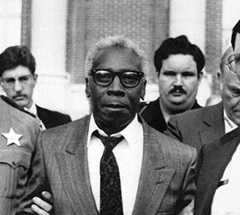On April 25…
“Remember, where you have a concentration of power in a few hands, all too frequently men with the mentality of gangsters get control. History has proven that.”
~Lord Acton

1719 – Daniel Defoe’s fictional work The Life and Strange Adventures of Robinson Crusoe was published. The book, about a shipwrecked sailor who spends 28 years on a deserted island, was based on the experiences of shipwreck victims and of Alexander Selkirk, a Scottish sailor who was marooned on a small island ( Juan Fernández Archipelago) 420 miles off the coast of Chile from 1704-1709.
Much of Selkirk’s time on the island was spent in the cave shown above, although he also built two small huts at a higher elevation.

1792 – Highwayman (robber) Nicolas Jacques Pelletier became the first person under French law to be executed by guillotine. The crowd expressed their disgust with the new execution method, but not for reasons you might expect. The problem, as they saw it, was the guillotine was too swift and “clinically effective” to provide proper “entertainment,” as compared to previous execution methods, such as hanging, death-by-sword, or breaking at the wheel.
But over time, the executions became popular entertainment and attracted huge numbers of spectators. A group of female citizens known as the tricoteuses (“knitters”) became regulars, functioning as macabre cheerleaders as they watched while knitting.
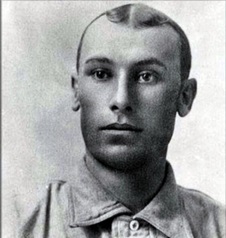
1901 – Erve Beck of the Cleveland Blues hit the first home run in American League history.

1901 – New York became the first state to require auto license plates. The plates were made by individual owners (with the owner’s initials) rather than being issued by state agencies. It wasn’t until two years later, in 1903, that the first state-issued license plates were distributed in Massachusetts. The very first plate, featuring the number “1,” was issued to Frederick Tudor.

1915 – The invasion of the Turkish Gallipoli Peninsula by British, French, Indian, Newfoundland, Australian and New Zealand troops, began with landings at Anzac Cove and Cape Helles. The allies aim was to drive the Ottoman Turkish Empire out of World War I.
The Turkish forces were well prepared to meet them, however, as they had long been aware of the likelihood of just such an invasion. During the next three months, the Allies made only slight gains off their landing sites and sustained terrible casualties. A new British landing at Suvla Bay in August resulted in even more losses.
In January 1916, Allied forces staged a full retreat from the shores of the peninsula, ending a disastrous campaign that resulted in 250,000 Allied casualties and a greatly discredited Allied military command, including a young Winston Churchill, who resigned as first lord of the Admiralty.
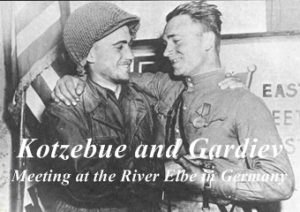
1945 – April 25, 1945 — Elbe Day — marks one of the turning points not only of World War II, but of world history. Eight Russian armies completely encircled Berlin. When they inked up with the U.S. First Army patrol; first on the western bank of the Elbe River (where First Lieutenant Albert Kotzebue met Russian Lt. Col Alexander Gardiev), and then later at Torgau, Germany was, for all intents and purposes, Allied territory.
Statements were released simultaneously in London, Moscow, and Washington that evening, reaffirming the determination of the three Allied powers to complete the destruction of the Third Reich. In Moscow, news of the link-up between the two armies resulted in a 324-gun salute. In New York City, crowds burst into song and danced in the middle of Times Square.
“This is not the hour of final victory in Europe, but the hour draws near, the hour for which all the American people, all the British people and all the Soviet people have toiled and prayed so long.” ~President Harry Truman

1945 – With allied troops advancing into northern Italy, and the collapse of Benito Mussolini’s puppet Italian Social Republic imminent, he and his mistress Clara Petacci set out for Switzerland, intending to board a plane and escape to Spain.
The story will continue on Saturday.
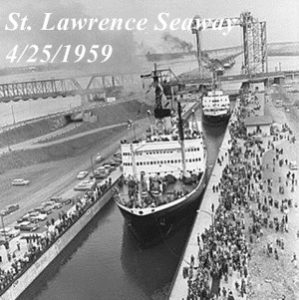
1959 – The St. Lawrence Seaway, linking the Atlantic Ocean and the Great Lakes, opened for shipping. It was not an easy process. The project that had been supported by every administration from Woodrow Wilson through Dwight Eisenhower.

1965 – 16-year old Michael Andrew Clark took up a position overlooking Highway 101 near Orcutt, CA and began shooting at cars as they passed. The night before the shooting spree, Clark had stolen his parents’ car and left his home in Long Beach, CA. He brought his father’s pistol and .30-06 Swedish Mauser rifle with him.
During the shooting spree, two people were killed at the scene. Twelve more were injured. One of the injured victims, a five year old boy, died the next day from his wound.
After more than an hour long gun battle with police officials, Clark shot and killed himself. No motive for the shooting spree was ever determined.

1976 – During a game at Dodger Stadium, two protesters, William Thomas and his 11-year-old son, ran into the outfield and tried to set fire to an American flag. Rick Monday, an outfielder with the Chicago Cubs, dashed over and grabbed the flag to thunderous cheers.
He later said, “If you’re going to burn the flag, don’t do it around me. I’ve been to too many veterans’ hospitals and seen too many broken bodies of guys who tried to protect it.”
1989 – James Richardson walked out of a Florida prison 21 years after being wrongfully convicted of killing his seven children by lacing their lunches with pesticide. Special prosecutor Janet Reno agreed to the release after evidence showed that he had been framed by authorities and gross misconduct by the prosecutor.
In addition, neighbor Bessie Reece, the woman who had been babysitting Richardson’s children while he and his wife were away working, had confessed to the crime to a nursing home employee. Reese – mentally incompetent with Alzheimer’s disease at the time of her “confession” – had been on parole at the time of the murders for killing her ex-husband with poison.
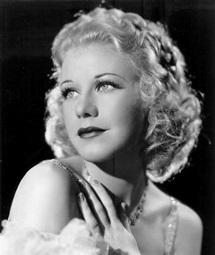
1995 – Actress Ginger Rogers (won the Academy Award for Best Actress in Kitty Foyle, but best known for the 10 films she made with her dance partner Fred Astaire) died of a heart attack at the age of 83.

1999 – More than 70,000 mourners gathered in Littleton, Colorado to honor the victims of the Columbine High School massacre five days earlier. “All of us must change our lives to honor these children,” Vice President Al Gore told the crowd. “More than ever, I realize every one of us is responsible for all of the children.”
2009 – Actress Bea Arthur (Maude and The Golden Girls) died of cancer at the age of 86.
Compiled by Ray Lemire ©2018 RayLemire.com. All Rights Reserved.
